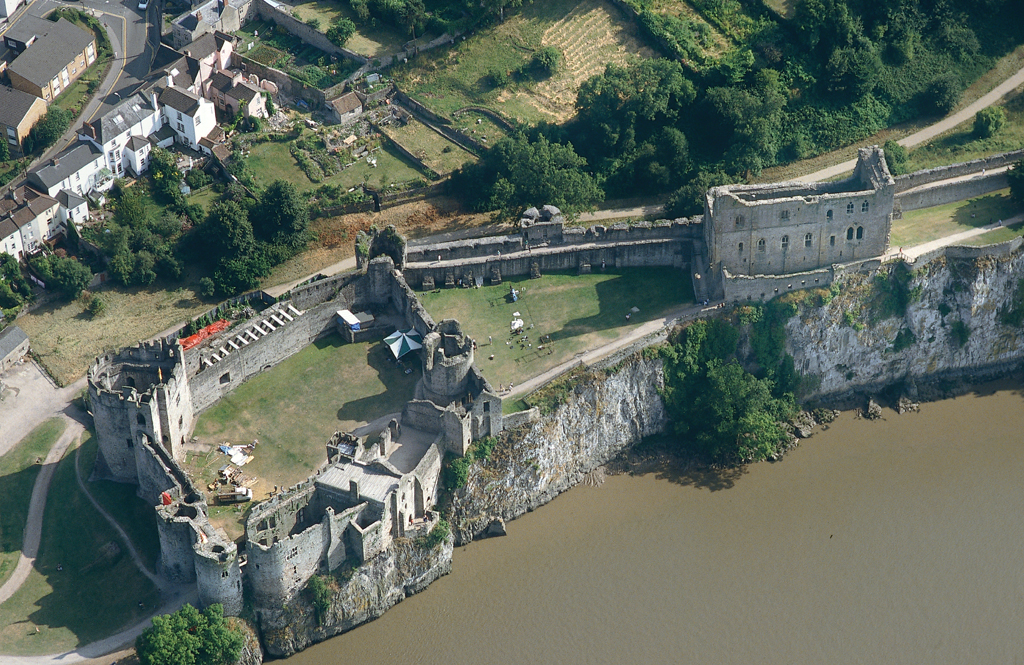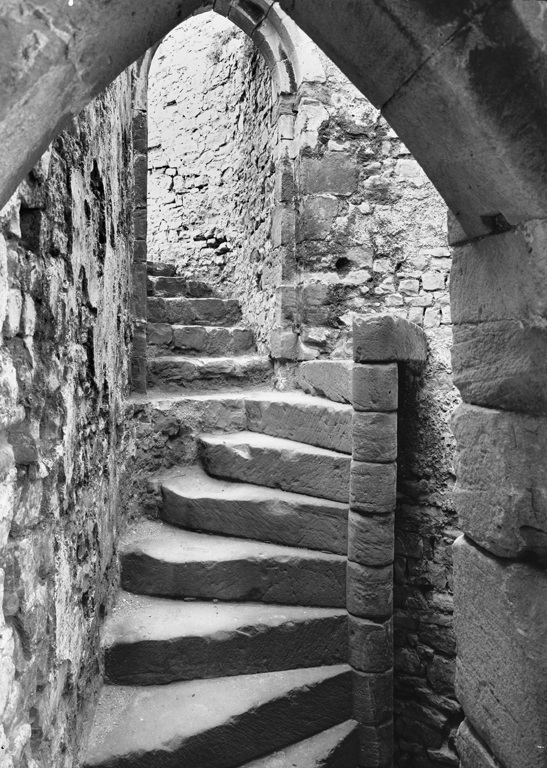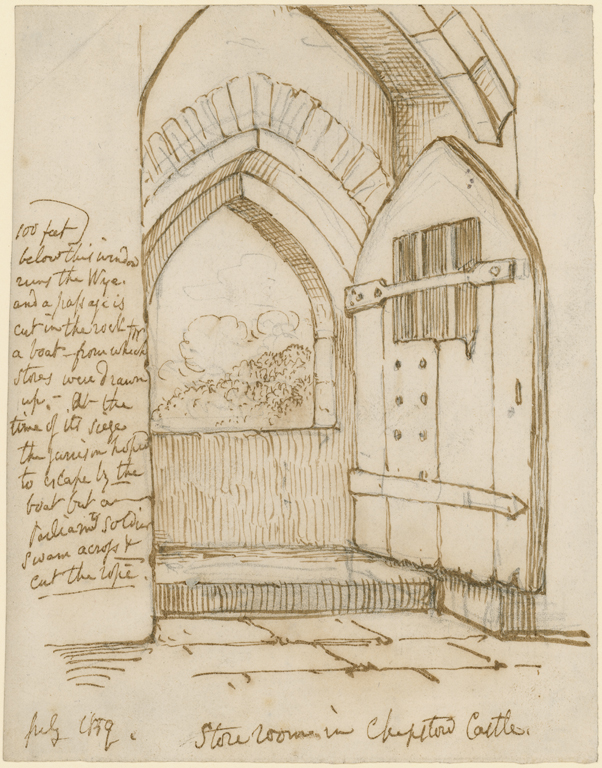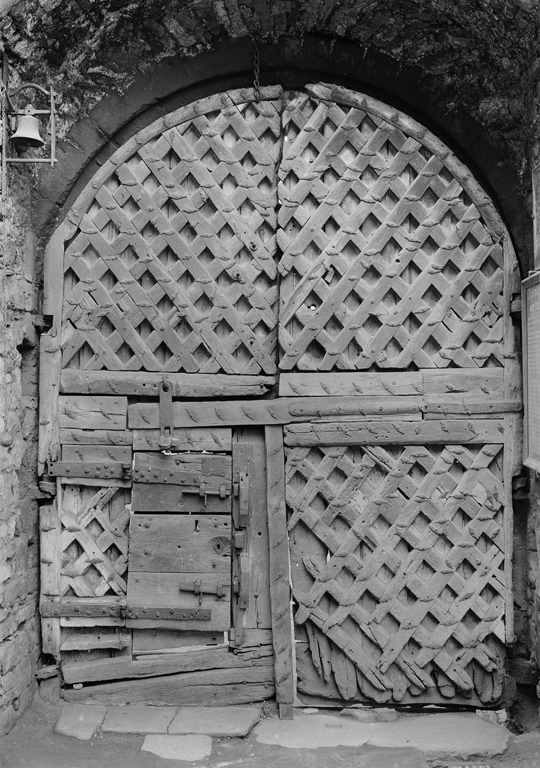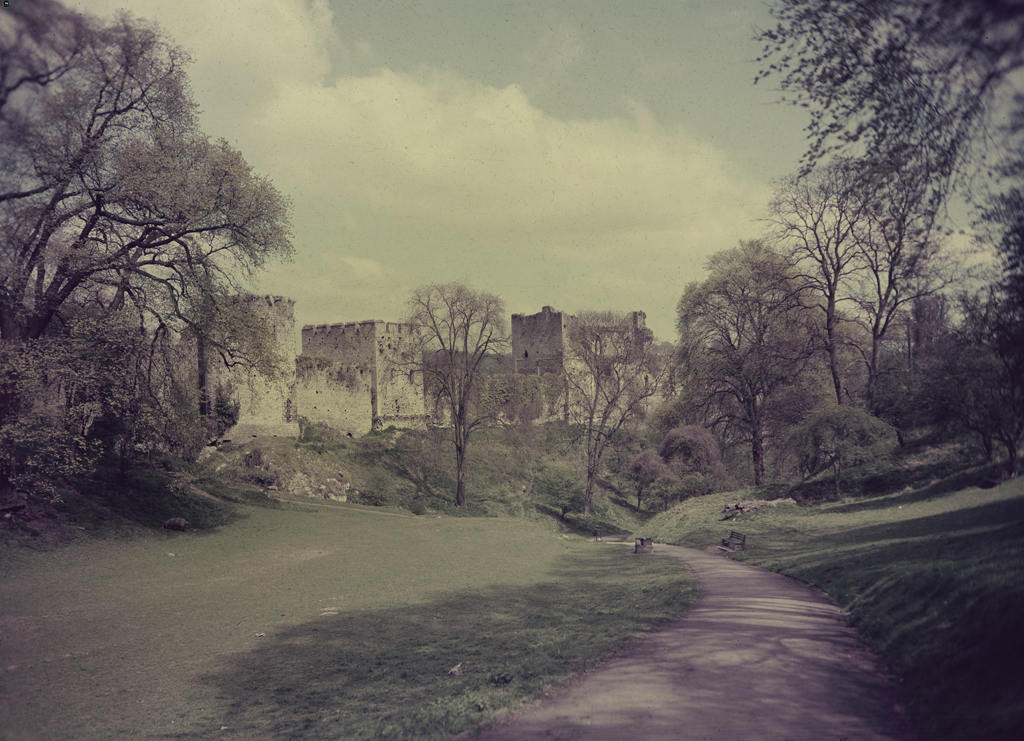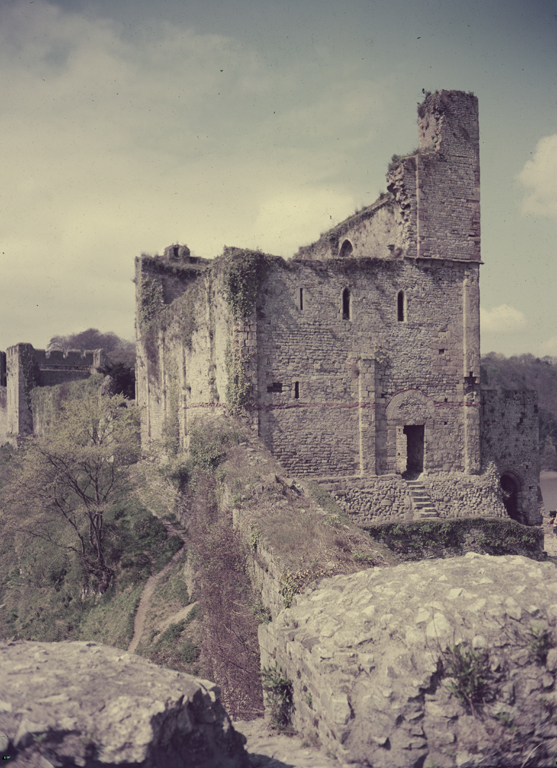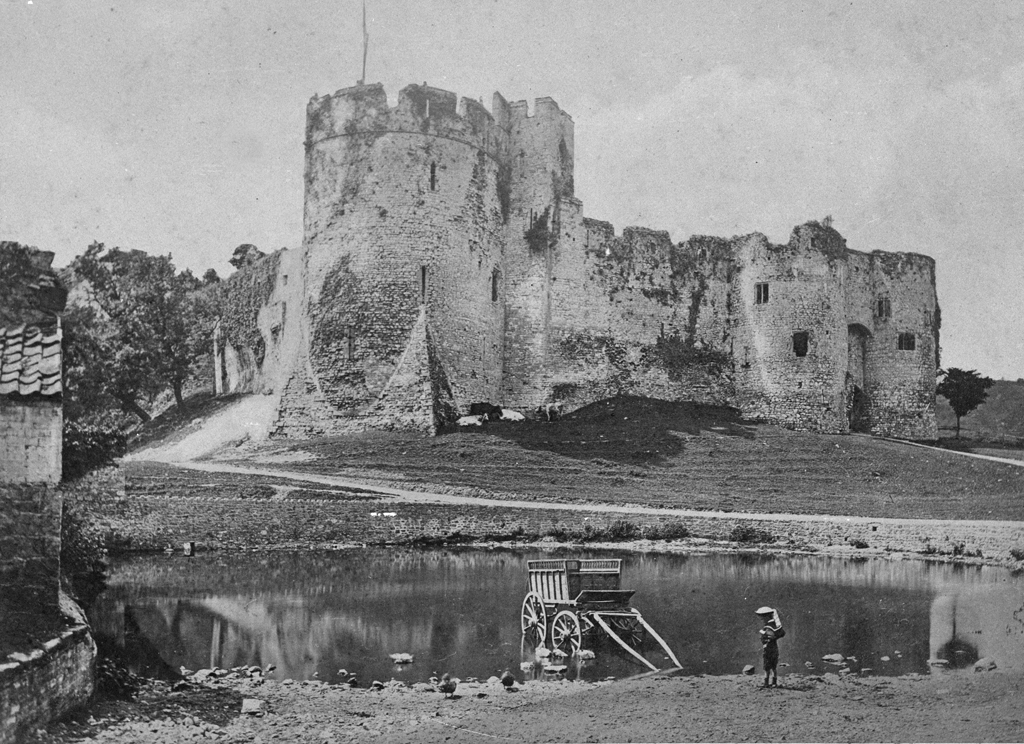Chepstow Castle - Overview
There has been a castle on this strategic site overlooking the River Wye since 1067 and it is one of the most impressive castles in Wales. Chepstow Castle was refortified by William Marshall between 1190 and his death in 1219 and then further enhanced by Roger Bigod in the 1270s. The castle was garrisoned during the Glyndwr rebellion and was besieged twice during the English Civil War.
Following the end of the English Civil wars and the restoration of the monarchy, Chepstow Castle served as a garrison and gaol. Marten Tower is named after its most famous prisoner, Henry Marten, who signed the death warrant for Charles I and died in this castle in 1680. Shortly after his death, the garrison was disbanded and the castle fell into decay.
With the rise of modern tourism in the late eighteenth century, the now ruined Chepstow Castle was rediscovered by travellers in search for picturesque Wales. Among the earliest travellers from Germany was Carl Gottlob Küttner who visited in 1784. Impressed by the history of the castle, its historic prisoners and prime location on the Wye, he very much regretted not having had more time on his hands to stay a bit longer and draw it from all sides. The Breton, Armand-Louis-Bon Maudet, Comte de Penhouët, visited twelve years later and he was overcome by the architecture, history and beautiful surroundings. His busy travel plan did not allow him to stay long either, but he did find enough time in his travel description to praise the services and kindness of Mrs Williams, the resident tourist guide in the employ of the owner of the castle, the Earl of Beaufort.
Accounts of Travel
Reise durch England, Wales und Schottland im Jahre 1817, 1816
Samuel Heinrich Spiker (1786 – 1858)
Eben so gut erhalten, als das von Caernarvon, und einst, seiner ähnlichen Lage in der Nähe des Meeres wegen, eben so fest als dieses, erhält es durch seine Ausdehnung eine größere Bedeutsamkeit. Es hat vier Höfe; fünf oder sechs gewaltige Thürme, stehen noch ziemlich unversehrt da, und von der, einst sehr stattlichen, 2 Stockwerk hohen Kapelle sind die Außenmauern noch vollständig erhalten. Die große Halle wird jetzt als Gewächshaus benutzt und die übrigen bewohnbaren Zimmer sind verpachtet. Wir hatten nicht Muße genug, das Innere zu besichtigen: der Anblick des Aeußeren ist, besonders von der neuen Brücke aus gesehen, ungemein imposant, während er etwas Eigenthümliches dadurch erhält, daß die Trümmer gleichsam eine Masse mit dem Felsen, auf dem sie stehen, zu bilden scheinen, indem sowohl dieser, als das Gebäude, von unten bis oben mit einem Ueberzuge von Epheu bedeckt sind, der sich in dem Flusse, an dem das Castell liegt, freundlich abspiegelt. Die Brücke ist so eben, nach ihrem letzten Umbau, fertig geworden, und hat jetzt statt der hölzernen Ueberlage eiserne Bogen erhalten, die durch ihre Leichtigkeit und Nettigkeit beweisen, welche große Fortschritte die Eisengießerei in England seit der Anlegung der Brücke von Colebrook-Dale gemacht hat. Besonders gefällig ist das eiserne Geländer verziert. Die fünf Pfeiler, auf denen die Brücke ruht, sind von einem feinkörnigen weißen Sandstein aufgeführt und länglich rund: an Niederreißung der alten, zwischen ihnen stehenden, wurde so eben gearbeitet. Der mittlere Bogen ist der größte, die übrigen nehmen an Spannung gegen die Ufer hin ab.
In as good preservation as the castle of Caernarvon, and formerly on account of its being similarly situated in the vicinity of the sea, possessing equal strength, it derives superior consequence from its greater extent. It has four courts; five or six large towers are still in tolerable preservation; and the outer walls of the chapel, which is two stories in height, and which was once very magnificent, are still entire. The great hall is now used as a greenhouse, and such of the rooms as are still tenantable are let out. We had not leisure to view the interior. The appearance of the exterior, especially from the new bridge, is particularly striking, from the ruins appearing to form one mass with the rock on which they stand, both being covered from top to bottom with a mantle of ivy, beautifully reflected in the river on which the castle stands. The bridge, formerly of wood, has lately been succeeded by iron arches, which from their lightness and neatness, prove the great progress made in the casting of iron in England, since the bridge at Colebrooke-dale was constructed. The iron rails are particularly handsome. The five piers of the arches are of a fine grained white sand-stone, and of an oblongish round form. We found the work men employed in pulling down the old piers still remaining between them. The centre arch is the largest, the others diminish in span towards the banks.
(Travels through England, Wales and Scotland in the Year 1816. 2 vols. London: 1820)
Beyträge zur Kenntniss vorzüglich des Innern von England und seiner Einwohner, 1783
Carl Gottlob Küttner (1755 – 1805)
Das alte Schloß zu Chepstow (Chepstow Castle), das am Ufer des Flusses auf einer schroffen Felsenwand steht, gehört ebenfalls dem Herzog von Beaufort. Es ist schön, edel und von einem Umfange, daß man eine kleine Armee hinein legen könnte. Der Haupteingang steht fast noch ganz und ist normannisch. In einem der Zimmer zeigte man uns das, in welchem Heinrich Martin, einer von Carls l. Blutrichtern, Jahre lang saß und starb.
Der schöne Ueberrest dieses Schlosses, so wie der von Tintern Abbey, nicht weit von hier, wird von der nämlichen Hand, wie die Ruinen des Schlosses zu Rayland [Raglan], wider fernere Verheerungen geschützt.
Könnte ich einige Tage länger hier bleiben, ich sollte von diesem Schlosse und der Gegend umher ein ganzes Dutzend Zeichnungen aufnehmen, die alle gleich malerisch und gleich mannigfaltig seyn sollten.
Perched on a craggy cliff by the riverbank, the old castle in Chepstow also belongs to the Duke of Beaufort. It is handsome, noble and of such an extent that a small army could camp here. The main gate is still almost complete and of an entirely Norman manner. In one of the rooms we were shown, Henry Martin, one of Charles I’s sanguinary judges, was kept prisoner for many years and died.
The beautiful remnants of the castle, just like those of Tintern Abbey not far from here and the ruins of Raglan Castle, are defended against further destruction by the hands of the Duke.
Could I remain here for a few days, I would like to make a dozen drawings of this castle and the surroundings, which should all turn out equally picturesque and diverse.
"Voyage dans le pays de Galles", 1862
Alfred Erny (1838 – )
Je m’arrêtai à Chepstow. La position de cette ville sur la charmante rivière de Wye, près de son confluent avec la Severn, est des plus pittoresques. Dans le jardin d’une maison de la rue du Pont (Bridge-Street), on me fit voir un curieux puits qui se vide et se remplit en sens inverse du flux et du reflux de la mer. Quand la marée est à son point le plus élevé, il est parfaitement sec ; et peu de temps après le reflux, l’eau revient. Ce réservoir a trente-deux pieds de profondeur, et contient jusqu’à quatorze pieds d’eau d’une excellente qualité.
Le château est construit sur un haut rocher : l’entrée est défendue par deux tours massives dans le style normand. Un boulet attaché à une chaine de fer tient lieu de sonnette. On me montra d’abord, dans la première cour, la grande salle et le donjon où fut enfermé pendant vingt ans Marten un des juges de Charles Ier. Jeremy Taylor fut aussi emprisonné dans ce château en 1656. La seconde cour est transformée en jardin. Dans la troisième, on remarque quinze arceaux parfaitement conservés qu’on dit avoir appartenu à la chapelle. D’une chambre taillée dans le roc, on aperçoit les sinuosités de la Wye couverte de grands bois touffus. En sortant du château, je traversai le pont de fer de la Wye, et je montai sur une hauteur désignée sous le nom de Double View. On y jouit d’une vue splendide des environs de Chepstow.
I stopped at Chepstow. This town’s position on the charming river Wye, near the latter’s confluence with the Severn, is most picturesque. In the garden of a house in Bridge Street I was shown a curious well that fills and empties in inverse proportion to the tide. At hight tide it is totally dry, and soon after the ebb the water returns. This reservoir is thirty-two feet deep and contains up to forty feet of excellent quality water.
The castle stands on an elevated rock, with its entrance defended by two massive towers in the Norman style. A cannon ball attached to an iron chain serves as doorbell. In the first courtyard I was shown the great room and the donjon tower where Marten, one of Charles I’s judges was held for twenty years. Jeremy Taylor was also imprisoned in this castle in 1656. The second courtyard has been transformed into a garden. In the third there are fifteen perfectly preserved arches that apparently once belonged to the chapel. From a room carved from the rock you can catch a glimpse of the Wye meandering through thick woods. As I left the castle I crossed the iron bridge over the Wye and climbed to a high point known as Double View. It boasts splendid views of the Chepstow area.
